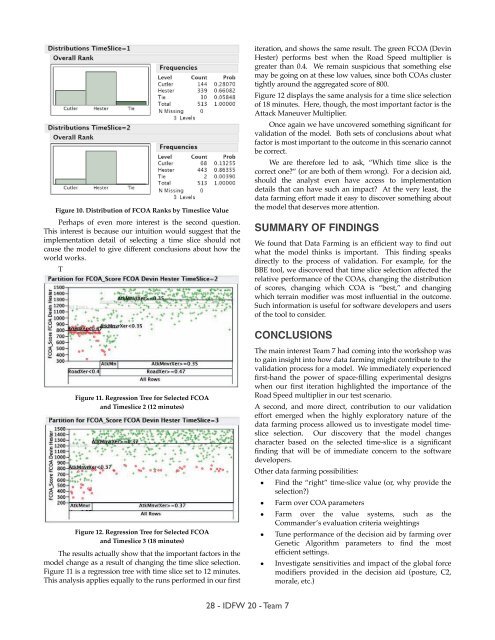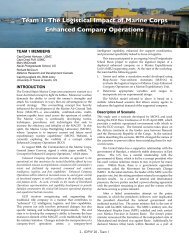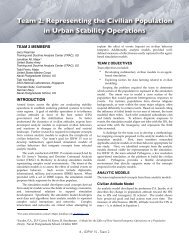pdf file - SEED Center for Data Farming - Naval Postgraduate School
pdf file - SEED Center for Data Farming - Naval Postgraduate School
pdf file - SEED Center for Data Farming - Naval Postgraduate School
You also want an ePaper? Increase the reach of your titles
YUMPU automatically turns print PDFs into web optimized ePapers that Google loves.
Figure 10. Distribution of FCOA Ranks by Timeslice Value<br />
Perhaps of even more interest is the second question.<br />
This interest is because our intuition would suggest that the<br />
implementation detail of selecting a time slice should not<br />
cause the model to give different conclusions about how the<br />
world works.<br />
T<br />
Figure 11. Regression Tree <strong>for</strong> Selected FCOA<br />
and Timeslice 2 (12 minutes)<br />
Figure 12. Regression Tree <strong>for</strong> Selected FCOA<br />
and Timeslice 3 (18 minutes)<br />
The results actually show that the important factors in the<br />
model change as a result of changing the time slice selection.<br />
Figure 11 is a regression tree with time slice set to 12 minutes.<br />
This analysis applies equally to the runs per<strong>for</strong>med in our first<br />
iteration, and shows the same result. The green FCOA (Devin<br />
Hester) per<strong>for</strong>ms best when the Road Speed multiplier is<br />
greater than 0.4. We remain suspicious that something else<br />
may be going on at these low values, since both COAs cluster<br />
tightly around the aggregated score of 800.<br />
Figure 12 displays the same analysis <strong>for</strong> a time slice selection<br />
of 18 minutes. Here, though, the most important factor is the<br />
Attack Maneuver Multiplier.<br />
Once again we have uncovered something significant <strong>for</strong><br />
validation of the model. Both sets of conclusions about what<br />
factor is most important to the outcome in this scenario cannot<br />
be correct.<br />
We are there<strong>for</strong>e led to ask, “Which time slice is the<br />
correct one?” (or are both of them wrong). For a decision aid,<br />
should the analyst even have access to implementation<br />
details that can have such an impact? At the very least, the<br />
data farming ef<strong>for</strong>t made it easy to discover something about<br />
the model that deserves more attention.<br />
SUMMARY OF FINDINGS<br />
We found that <strong>Data</strong> <strong>Farming</strong> is an efficient way to find out<br />
what the model thinks is important. This finding speaks<br />
directly to the process of validation. For example, <strong>for</strong> the<br />
BBE tool, we discovered that time slice selection affected the<br />
relative per<strong>for</strong>mance of the COAs, changing the distribution<br />
of scores, changing which COA is “best,” and changing<br />
which terrain modifier was most influential in the outcome.<br />
Such in<strong>for</strong>mation is useful <strong>for</strong> software developers and users<br />
of the tool to consider.<br />
CONCLUSIONS<br />
The main interest Team 7 had coming into the workshop was<br />
to gain insight into how data farming might contribute to the<br />
validation process <strong>for</strong> a model. We immediately experienced<br />
first-hand the power of space-filling experimental designs<br />
when our first iteration highlighted the importance of the<br />
Road Speed multiplier in our test scenario.<br />
A second, and more direct, contribution to our validation<br />
ef<strong>for</strong>t emerged when the highly exploratory nature of the<br />
data farming process allowed us to investigate model timeslice<br />
selection. Our discovery that the model changes<br />
character based on the selected time-slice is a significant<br />
finding that will be of immediate concern to the software<br />
developers.<br />
Other data farming possibilities:<br />
• Find the “right” time-slice value (or, why provide the<br />
selection?)<br />
• Farm over COA parameters<br />
• Farm over the value systems, such as the<br />
Commander’s evaluation criteria weightings<br />
• Tune per<strong>for</strong>mance of the decision aid by farming over<br />
Genetic Algorithm parameters to find the most<br />
efficient settings.<br />
• Investigate sensitivities and impact of the global <strong>for</strong>ce<br />
modifiers provided in the decision aid (posture, C2,<br />
morale, etc.)<br />
28 - IDFW 20 - Team 7




